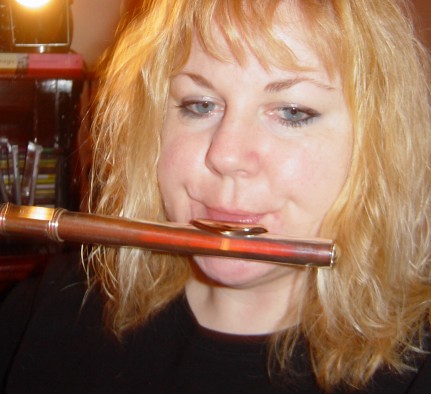 |
| Photo by angelaathomas |
The other wind instruments have mouthpieces or reeds to guide their air, and the string family has a bow and resonating box built into the instrument that assists tone production. Understanding 3 basic principles will help beginning and intermediate flute players to both improve their tone on the instrument and make the good tone a consistent part of their playing.
The first principle of good tone is to get as much of your bottom lip on the lip plate as possible. Draw the corners of your lips forward so that they are hugging the lip plate. Do NOT pull them back in a smiling position. Bringing the corners of your lips forward creates more space in your mouth, therefore contributing to the size of your "resonating box". As a flute player, your resonating box consists of the sinus cavity, the space in your mouth and throat, and the chest cavity. This simple act also allows you to engage all of the muscles around your mouth area, which will give you more strength and flexibility when you attempt to change octave.
The second principle of good tone is to understand register production. The flute is capable of playing comfortably in 3 registers - low, middle, and high. It is the direction of your air column (the stream of air you are blowing over the tone hole) that will produce the register you are seeking to play. This should be the primary way you change your register. If you blow your air down, or more directly into the tone hole, you will produce the low register.
The middle register is produced by blowing your air straight out across the tone hole (a parallel line from the hole you are making with your lips), and the high register is produced by directing your air column up like you are trying to blow a bee off of your nose. Other factors will contribute to the production of the different registers, but they should not be your primary focus because you will find that they all have their primary functions. For example, if you increase the size of the hole you are making with your lips, you will find the low register, but you will have also affected the color and pitch of your tone.
The third principle of good tone is to play with good, relaxed posture. Remember, the flute requires the performer's body to be its resonating box. Therefore, a flutist must sit up straight in his or her chair, or stand tall, when playing. Also, the flute requires the left arm of the player to reach across his or her body. A flutist must always remember to keep his or her shoulders square so that this arm does not decrease the size of the box around the lungs. The performer should attempt to play with as little tension in his or her muscles as possible so that tightened muscles do not inhibit the ability of the body to vibrate.
Of course, all of these techniques take practice and time to master, but with careful attention, determination, and practice, every flutist can play with the beautiful tone he or she desires.

No comments:
Post a Comment